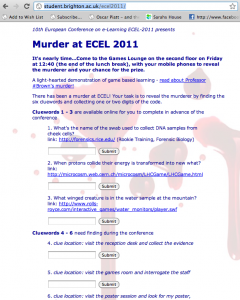A whodunnit murder mystery was to be solved during the conference, through clues and a website to track progress. The clues required engagement with online learning activities. There was a small, but very engaged, set of players.
The Event:
Katie Piatt and Steve Kilgallon from the University of Brighton were asked to help plan and run a game to demonstrate games based learning at the European Conference on eLearning. The conference was at the University of Brighton from 9-11 Nov 2011.
The Gamification activity:
We decided to make the game not only an entertaining activity running alongside the conference, but also use examples of games-based learning within the game. We chose a Cludeo/Whodunnit scenario, as something an international audience could all identify with. With 6 clues: 3 activities that could be completed online through existing websites, released on the Monday of the conference week (Weds, Thurs, Fri) and 3 that required looking for or speaking to somebody at the conference itself.
Here is an example of an online clue:
What’s the name of the swab used to collect DNA samples from cheek cells?
link: http://forensics.rice.edu/ (Rookie Training, Forensic Biology)
The final clue: The 6 clues gave the players 6 numbers. Once invited to the reveal they were given one final clue on a piece of paper and had to race each other to add 11, subtract 12 etc to reveal a number, then work out it was a phone number (‘Ring my Bell’ was being played loudly while they worked this out) add a leading zero to their number and then dial it. We spent £6.99 on a cheap mobile phone with minimal credit and gave it to one of the conference organisers (Asher Rospigliosi) who was happy to play along and act it up when his phone rang revealing him as the murderer!
Engagement:
With a captive audience of nearly 200 conference goers, interested in eLearning we were hopeful that of the order of 50 might complete the game. In fact the figures were 41 for the first online clue, then descending down to 11 who eventually completed all 6 tasks and logged their email address. About 6 of these came to the final reveal as some had already left by lunchtime on the last day.
Lessons and Tips:
1. Keeping it simple: The three clues at the conference were all pretty easy, which meant we didn’t lose players through trying to be overly cryptic. eg The ‘poster’ clue required them to spot that one of the posters on display was by Professor #Brown, pretty easy as it was of four elephants, with ‘elephant’ being the answer they were looking for.
2. The reveal location: Because we were unclear on how much take-up there would be, we left our options open regarding when to reveal the murderer; either on the Thursday night at the conference dinner, or at the lunch break the next day. In the end we decided on the Friday lunchtime to allow extra time for players to complete the clues and to allow the finale a more intimate space (where you could hear a phone ring) than in the large dinner venue (the Brighton Dome).
3. Data Logging: The website was a basic html form to check the responses, but everything entered was logged to a text file. This was a simple technical solution to set up, but gave us a very clear idea of how players were progressing and assess take-up throughout the day.
4. Technology choices: Some of the online activities required Flash, which meant delegates on iPads or iPhones couldn’t complete the clues without finding a computer.
5. Optimistic social media: I tried creating an #ecelmurder hashtag for the game, but it didn’t really take off, and all the conference activity was on #ECEL2011 which I used in all tweets anyway. It’s own hashtag wasn’t necessary.
6. As is often the way with these kind of pseudo-Alternate Reality Games, the clue solving/puzzle activity ends up quite remote from the story-line. Although we had created a back story for our victim, it was not important in order to solve the clues. I’d like to find a way of making it integral, perhaps with clues on a (fictitious) blog etc.
Further Information and Links:
- This case study is adapted from the original blog post: http://katiepiatt.blogspot.co.uk/2011/11/running-conference-murder-mystery-game.html



